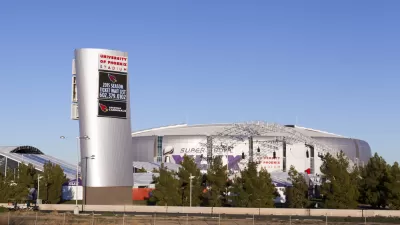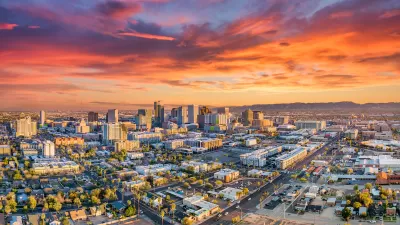Mark Byrnes breaks down the math on this year's Super Bowl and finds the host city of Glendale, Arizona getting shortchanged.

Mark Byrnes balances the checkbook on the city of Glendale, Arizona's investment in the University of Phoenix Stadium and finds that the city's interests fall wall short of the NFL's.
First of all the cost to the taxpayers of the city and the state: "$302.3 million from the Arizona Sports and Tourism Authority and $9.5 million from the City of Glendale to build the stadium. (The team contributed $143.2 million.)"
Then this weekend, "the Phoenix suburb is expecting to spend $2.1 million on security for Super Bowl week."
Then there's the revenue expected to return to the city as a result of this weekend's hoopla: "PricewaterhouseCoopers estimates $206 million in direct spending (tourism, lodging and transportation) will flow into the metro area as a result of this year's Super Bowl, but adds that after inflation the figure is two percent lower than projected for Glendale's first Super Bowl, back in 2008. For that event, the city of Glendale collected approximately $1.24 million in direct revenue and state shared sales taxes."
Which, Byrnes concludes, is "not an especially exciting bottom line considering more than 40 percent of Glendale's current debt 'is dedicated to paying off sports complexes,' as reported in the New York Times last weekend."
The article includes more details on how the NFL makes the case for new stadium investments and how localities get the short end of the stick, including the example of East Rutherford, New Jersey, which hosted the event in 2014.
FULL STORY: The Burden of Hosting a Super Bowl

Alabama: Trump Terminates Settlements for Black Communities Harmed By Raw Sewage
Trump deemed the landmark civil rights agreement “illegal DEI and environmental justice policy.”

Planetizen Federal Action Tracker
A weekly monitor of how Trump’s orders and actions are impacting planners and planning in America.

The 120 Year Old Tiny Home Villages That Sheltered San Francisco’s Earthquake Refugees
More than a century ago, San Francisco mobilized to house thousands of residents displaced by the 1906 earthquake. Could their strategy offer a model for the present?

Ken Jennings Launches Transit Web Series
The Jeopardy champ wants you to ride public transit.

BLM To Rescind Public Lands Rule
The change will downgrade conservation, once again putting federal land at risk for mining and other extractive uses.

Indy Neighborhood Group Builds Temporary Multi-Use Path
Community members, aided in part by funding from the city, repurposed a vehicle lane to create a protected bike and pedestrian path for the summer season.
Urban Design for Planners 1: Software Tools
This six-course series explores essential urban design concepts using open source software and equips planners with the tools they need to participate fully in the urban design process.
Planning for Universal Design
Learn the tools for implementing Universal Design in planning regulations.
Clanton & Associates, Inc.
Jessamine County Fiscal Court
Institute for Housing and Urban Development Studies (IHS)
City of Grandview
Harvard GSD Executive Education
Toledo-Lucas County Plan Commissions
Salt Lake City
NYU Wagner Graduate School of Public Service





























